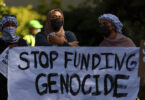Kristen A. Cordell
China has long presented its views on major policy issues for public consumption through white papers, and the issue of development assistance is no different. China has released three white papers defining its approach to foreign assistance: in 2011, 2014, and most recently in January 2021. The latest document—much longer than its predecessors—is China’s first white paper on development since overhauling crucial aspects of its development approach in 2018.
The document offers high-level principles that China claims to ascribe to in its approach to foreign aid and forward-looking development priorities. While some concepts are carried over from prior papers, the 2021 version expands on the vision articulated by its predecessors. Many of its new terms seem to be in direct response to recent critiques of China’s flagship push to fund physical and digital infrastructure overseas through the Belt and Road Initiative (BRI). Those critiques, originating from both BRI recipients and Western donors, have centered around the lack of control and ad hoc nature of Chinese transactions in the developing world.
China’s development assistance strategy should be evaluated not only by Beijing’s doubling down on rhetorical commitments to sustainability and accountability (and recurring themes like autonomy for developing countries) in the white paper, but also by its potential to impact the implementation of large-scale projects overseas. That assessment will take time, but in the interim policymakers would be wise to use clues from the white paper to better understand China’s evolving vision for assistance and how that might shape the country’s behavior across the developing world.
Chinese-style international development: The 2021 white paper calls for a new phase in Chinese development assistance focused on securing the country’s professed desire to uphold international order and usher in peace. It notably shifts toward an expanded and activist approach to multilateral rule setting and a normative pivot from the transaction-led activities that characterized the BRI’s first five years (2013–2017). While some language is carried over from past white papers—such as the concept of respect for equals and independent development—the 2021 iteration marks a watershed moment for how China wants to frame its assistance. Whether government officials responsible for BRI projects from Kenya to Myanmar ever read it is another question.
The white paper marks three important milestones in China’s quest to become a leading development partner. First, China created a new aid agency in 2018 called the China International Development Cooperation Agency (CIDCA). Chinese scholar Cheng Cheng has called its establishment an “initial step for China’s efforts to reform its foreign aid,” but he notes that it alone will not meaningfully reform China’s development practices. Cheng highlights the vast shortcomings CIDCA would need to overcome to manage the BRI, much less align the initiative with international standards for development (including on infrastructure). Second, the paper builds on Chinese outreach on development with partner countries and multilateral organizations through the 2018 and 2019 BRI forums, which featured high-level participants from the UN, the International Monetary Fund, and other multilateral organizations. Third, the paper coincides with the many formal BRI memorandums of understanding (MOUs) China has brokered with various partners, which skyrocketed from sixty-four in 2016 to 140 in 2020.
China has long relied on the original eight principles for assistance laid out by premier Zhou Enlai in 1964, which include mutual benefit, nonconditionality of assistance, and quick returns. The new principles enshrined in the latest white paper include mutual learning, sustainability, lasting impact, and breaking new ground. These four can be seen as a modern articulation of China’s values and a response to pushback over the negative impact of Beijing’s foreign lending on the economic growth of recipient countries. Some international critics have called the BRI predatory and argued that China pressures countries to take on exceptional levels of debt to finance questionable projects. They call attention to the harmful ways the BRI may hamstring recipients’ national autonomy by limiting private sector growth and participation by local laborers. Others have said the initiative is bloated due to poor management and ad hoc implementation, flagging Beijing’s shirking of critical environmental and social safeguards put in place to protect local populations in recipient countries.
While articulating new values and responding to critiques, China’s messaging is forward-looking and focused on the future. Whereas previous iterations framed Chinese development activities in narrow, historical terms, new sections in the 2021 edition leave little doubt that Beijing sees itself as a rule and norm setter for global development practices of the future.
Growing Chines multilateral engagement: As China ramps up its engagement with the UN and other key multilateral players, the 2021 white paper notably seeks to link the BRI to the UN’s poverty reduction vision in the 2030 Agenda for Sustainable Development (sometimes shortened to Agenda 2030). China is clearly prioritizing engagement in international organizations on both substantive and structural grounds. This is part of a larger, ongoing Chinese effort to assert itself in the international system and to craft those organizations in ways advantageous to Beijing’s interests. Meanwhile, Western capitals have expressed concerns that the United States may be abdicating its leadership of the international order to China. The underlying fear is that Western values risk being overshadowed by China’s preferences for impunity for corruption, restrictions on privacy and individual liberties, and limitations on protections for human rights, especially among minority communities.
Beijing’s desire to play a leadership role in the international order was evident during the 2018 and 2019 BRI forums, which high-level UN officials attended, including the UN secretary general. Speeches during the meetings called for significant cooperation between China and specialized UN-affiliated agencies. Since the 2018 forum, twenty specialized UN agencies have signed MOUs to directly cooperate with China on the BRI. Before the proliferation of these MOUs, it was rare for UN agencies to reach this type of bilateral agreement with a specific member state. These broad MOUs have created confusion about the nature of the multilateral partnerships and the intended outcomes China seeks.
The white paper goes beyond the platitudes and generalities expressed at the BRI forums and in the MOUs. It directly identifies technical areas for cooperation within the UN’s Agenda 2030, or the Sustainable Development Goals (SDGs), notably targets on poverty reduction, food security, healthcare, high-quality education, infrastructure, sustainability, economic growth, and environmental protection. China aims to make its plans in these technical areas dovetail with the overarching international Agenda 2030 framework for catalyzing action on the SDGs. While Washington was involved in the creation of Agenda 2030 in 2016, the US government has retreated from the framework over the past four years, a gap China has sought to fill, perhaps even more clearly through its latest white paper.
The paper also calls for more granular cooperation with specific UN-linked bodies, including the World Health Organization, the UN Educational, Scientific, and Cultural Organization, and the UN Relief and Works Agency for Palestine Refugees. It is no coincidence that these three organizations are ones the United States exited under former president Donald Trump.
It is clear that President Joe Biden and Vice President Kamala Harris have quickly recognized the pressing need for action to respond to this gap left by American leadership. It will be critical for the Biden administration not just to think about high-level membership and political overtures but also lower-level representation and standard setting when it comes to outreach to and cooperation with multilateral organizations.
Western policymakers are right to be concerned about China’s interest in setting multilateral technical standards, as Beijing seeks to remake the international governance system in its own image. China holds leadership positions in four of seventeen core, specialized UN agencies and has engaged at all levels of the International Telecommunications Union, the Food and Agricultural Organization, the UN Industrial Development Organization, and the International Civil Aviation Organization. These leadership roles, along with advocacy for China-friendly technical standards, is a readily apparent attempt to consolidate growing Chinese power and influence. One example is Chinese activism within the International Telecommunications Union, where Chinese officials have submitted technical proposals that, if adopted, would lead to a bifurcation of the internet across the developing world. Similarly, in the UN Human Rights Council, China has sought to limit civil society participation and protections for human rights defenders worldwide. These myopic, concrete actions could directly impact the overarching international development ecosystem and change how international bodies work with donors around the world. China’s interest in them should not be overlooked.
Finally, the white paper cites China’s commitment to improving overall “governance in international development cooperation, and safeguard[ing] the international system with the UN at its core.” This indicates China’s interest in the UN’s wider organizational management, structures, and potential reforms. This should be seen as an expansion beyond representational or technical topics designed to align the overall system (not just individual processes or policy positions) with China’s own interests. If successful, these efforts would have a significant impact on the future of the UN system.
Call and response: Strategically released at the outset of a new US administration, Beijing’s latest white paper directly responds to critiques of China’s development practices, handling of the coronavirus pandemic, and debt associated with Chinese lending. US policymakers in the Trump administration frequently called attention to rising debt levels in the developing world.
While the Biden administration’s position on this issue is not yet clear, the data on rising debt does leave reason for concern among development experts. The Financial Times has cited data from the World Bank showing that China’s share of bilateral debt that G20 members have lent to the developing world increased from 45 percent in 2015 to 63 percent in 2019. In the case of Ethiopia (which owes China some $13 billion) these debts are not easy to repay, as they are sometimes associated with unprofitable projects. The Ethiopia-Djibouti railway, for example, is plagued by power outages and lightly used and has failed so far to create the profits needed to repay China.
The money that Ethiopia and other borrowers owe China limits their ability to undertake other projects to foster growth. The critiques on the impact of these debts on developing countries’ autonomy are valid. New evidence shows that, even in refinancing, China seeks opportunities to push favorable lending terms that further its own interests. The white paper commits China to work bilaterally through South-South cooperation with “countries in difficulty for repayment of debts, and helps low-income countries to achieve debt sustainability.” Beijing seeks to recast itself from the role of (predatory) lender to that of (financing) partner. While it is not clear how this rebranding will play out, China clearly wants to minimize the spotlight on the impact of Chinese-held debt particularly in light of wider debt relief conversations, including those raised by G20 members.
Remaining questions: While the lengthy white paper offers a robust picture of China’s foreign assistance priorities and aspirations, it also raises several new questions for policymakers to consider.
First, what will the resulting balance be between China’s involvement with multilateral institutions versus bilateral support? Given the weight that Beijing is putting behind the international system, it is not clear if it will continue to promote bilateral actions over collective ones. This issue might prove particularly interesting in the humanitarian assistance space, which is new for China. Will Beijing go through existing mechanisms, run by the UN World Food Program, for example, or focus on country-level support? What will that mean for China’s accountability to international standards?
Second, what are the motivations behind China’s interests in data and accountability systems? The final paragraphs of the white paper state that China will “revise and improve the statistical indicator system of foreign aid, and develop a modern statistical information system for foreign assistance.” The inclusion of measurement and accountability is strange given consistent international critiques of China’s opaque assistance strategies and refusal to report publicly on its overseas development assistance.
The white paper does not commit to feeding into the system it has long shirked, but its words suggest that China would build something entirely new. International systems for measuring development assistance already exist, including that of the Organization for Economic Cooperation on Development. It is not clear why China would advocate for a new system, instead of buying into the existing one (especially in light of the white paper’s rhetorical commitment to multilateralism), except that it would allow China to continue to skirt internationally supported accountability metrics.
Third, what does China’s vision for CIDCA mean for activities in developing countries? The agency still lacks the authority and capabilities to meaningfully manage global projects. It is not clear what the white paper will mean for the agency’s structure, resources, or mission. Without additional implementation guidance, CIDCA is unlikely to become powerful enough in Beijing and will be even less likely to be able to coordinate BRI implementation in developing countries. Implementation is where a disconnect between vision and reality arises.
Early on, the white paper suggests that China’s assistance goes beyond BRI transactions. So what is China’s alternative vision of development? It is not clear how China will treat new efforts that do not fall under the umbrella of BRI. Xi is unlikely to scrap the BRI or its projects, but will they be folded into a larger effort? Or will there be a parallel development assistance portfolio that works alongside BRI transactions? China certainly has not approached international development in a holistic way but moving away from the BRI brand is likely to create even more confusion and diffusion. The paper leaves observers wondering: will the new schematic be a “BRI +” or everything “except the BRI”?
Conclusion: Rhetoric aside, the most impactful thing about the white paper that remains unknown is what it means on the ground in developing nations. Are BRI project leaders reading the document and beginning to adhere to its principles? Will it be accompanied by implementation guidance and/or budgetary priorities? Furthermore, how will this document impact the experiences of recipient countries. Will current recipients and potential recipients be more inclined to engage China as it puts the new principles into practice, or will they push back based on the growing critiques surrounding the long-term implications of debt-driven fiscal distress, environmental degradation, and limitations on human rights?
The white paper makes clear that China has entered a new phase of activist assistance in which it will rely heavily on international organizations and bilateral partnerships with developing countries. What is less clear is whether or not the new principles and strategy will result in improved implementation on the ground, nor how that implementation will impact the relationships between China and recipient nations.






